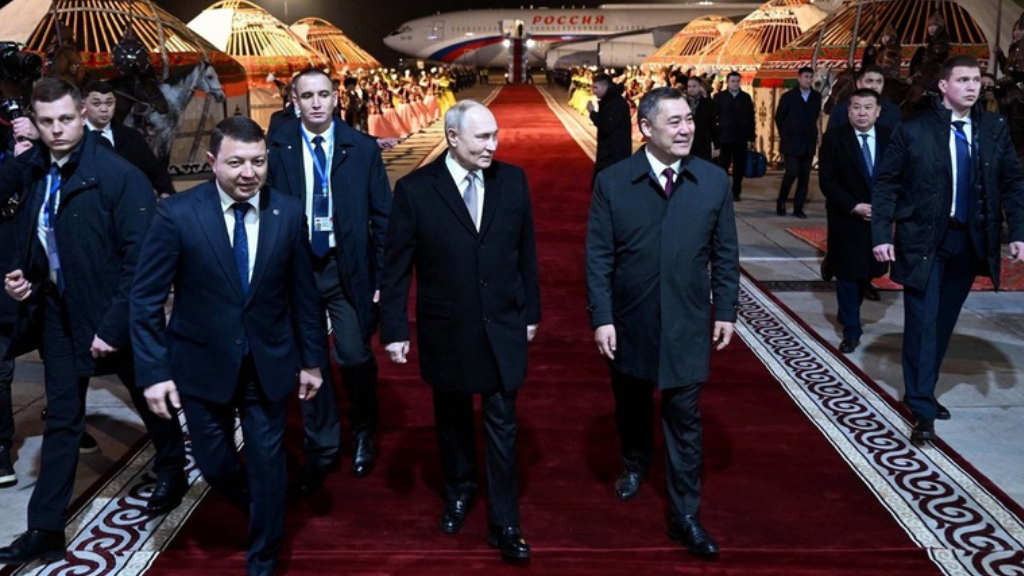The Russian President, Vladimir Putin, has arrived on a three day visit to Kyrgyzstan, where he is meeting with the Kyrgyz President, Sadyr Japarov to discuss further development of the strategic partnership and allied relationship between Russia and Kyrgyzstan in various areas. A joint statement by the heads of state, as well as a number of intergovernmental and business agreements have been prepared for signing.
Putin will also be attending the annual summit of the Collective Security Treaty Organization (CSTO) in Bishkek, bringing together foreign ministers, defense ministers, and security council secretaries from member states. That takes place on Thursday (November 26).
In this article we discuss Russia’s trade relations with Kyrgyzstan. The country serves as a link between China and the rest of Central Asia, an issue that will be enhanced when planned railway connectivity – the China-Kyrgyzstan-Uzbekistan railway – is operational. Construction began earlier this year and is expected to be completed by 2030.
Kyrgyzstan’s economy is supported by several key industries that are critical for its growth and overall development. Agriculture serves a significant portion of the population and ensuring essential food security. The country is recognized for producing various crops, including cotton, tobacco, and a diverse range of fruits and vegetables. Additionally, livestock farming plays a crucial role, contributing to both domestic consumption and exports, particularly in meat and dairy products. In terms of energy, Kyrgyzstan boasts considerable hydropower potential, which accounts for the majority of its electricity generation. The government focuses on expanding its hydropower infrastructure and is exploring renewable energy opportunities. Additionally, manufacturing is being revitalized through the establishment of new facilities and technological parks, with plans to launch over 100 industrial projects between 2024-26.
Kyrgyzstan is actively engaged in several free trade agreements to enhance its economic integration. It is a member of the Eurasian Economic Union (EAEU), which allows for the elimination of tariffs and trade barriers among member states. In June 2024, Kyrgyzstan ratified a trade agreement with Iran to bolster trade relations. Russian online retail investors such as Wildberries and Ozon have also established operations in Kyrgyzstan to help facilitate Kyrgyzstan’s trade with China.

With a population of approximately 7.2 million, Kyrgyzstan’s GDP (PPP) stands at around US$48.1 billion, GDP per capita (PPP) at US$6,790, and a projected GDP growth for 2025 at 6.8%.
Regarding bilateral trade with Russia, in 2021 it stood at US$2.49 billion, US$3.4 billion in 2022, and US$3 billion in 2023, increasing to just under US$4 billion in 2024, reflecting a significant rise, as both countries aim for a mutual trade target of US$5 billion.
As of November 2025, bilateral trade has grown over 17% for the year, suggesting a year end total of about US$4.68 billion will be achieved.
Key exports from Russia include refined petroleum, raw iron bars, and dried legumes, while Kyrgyzstan’s main exports to Russia include, washing and bottling machines, and light rubberized knitted fabric. There has been a recent increase in exports such as cosmetics, clothing, and fabric bags.
This relationship is further cemented by a large number of Kyrgyz citizens working in Russia, with their remittances accounting for a significant portion of Kyrgyzstan’s GDP.
Rosatom are developing wind and solar power farms in Kyrgyzstan, while the Central Asia Capital Investment Fund plans to launch an automobile plant in Kyrgyzstan for the assembly of Lada cars under the Muras brand in a technological partnership with Avtovaz. The launch of this facility will reduce Kyrgyzstan’s dependence on imports of used cars, the fund has said. Avtovaz is the parent company of Lada.
Russian investors may also be looking at Kyrgyzstan as a convenient ‘added-value’ manufacturing site, matching Chinese and Russian components to manufacture completed products for domestic sale as well as for the CIS and Chinese export markets.
Further Reading
Russia, Kyrgyzstan 2025 Bilateral Relations, Trade and Migrant Labour: Updates





